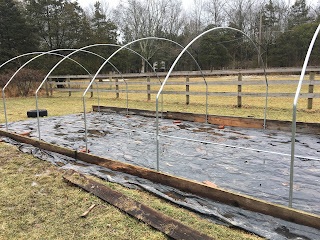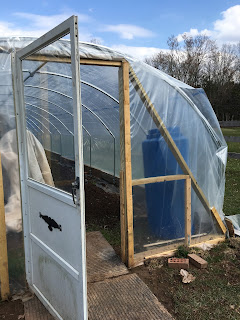Greenhouses have been used in agriculture since centuries. It's fascinating what difference passive solar heat can make in growing environment of plants. In the past, plants brought from tropical countries to colder regions of Europe were protected using glass walled structures that provided the needed warmth for them to thrive. From Europe to Asia, farmers have long been using protected structures like greenhouses, tunnels, walapinis and cold frames to provide the conditions necessary for native and non-native plants to thrive. Greenhouses have made it possible to breed and grow tropical crops in regions with harsh winters. Today, these greenhouses have enabled modern farmers, big and small, to extend their growing season so they continue generating income even in deep winters. Greenhouses are truly an ingenious invention and the advancements in their design and technology have contributed to the availability of wide variety of produce that we consume today.
A greenhouse, in broad sense, is any protected structure that provides growing conditions necessary for a plant when weather outside is less favorable. With that in mind, I built a small
12'x 50' unheated protected structure, lets call it a poly tunnel, in March this year on a site that received more than 7 hours of direct sunlight. The purpose of having in my production system were two fold: one, to give space to spring transplants growing in seed trays and second, to give an early start to a few crops. The surface of the poly tunnel was bare earth since crops would be direct seeded or transplanted in rows. And since the poly tunnel
survived two snow storms, I am confident I can put it to good use for this year (at least). I am sharing a few design details and it's performance so far.
I purchased this greenhouse from a company named
Growers Supply The size of greenhouse I purchased falls under Growers Span economy cold frame models. This is their low cost, basic model of a greenhouse with EMT hoops, UV treated polyethylene, purlin and screws. The advantage of purchasing a kit versus making your own was it came with all the needed parts which just have to be assembled in place. The disadvantage of such a kit was it still needed extra purchases and multiple trips to hardware store to complete the structure. The kit did not come with end walls, baseboard and any other additional support to provide strength to the structure.
Assembly and Construction
Besides being mechanically inept, heavy parts and tool make me turn my back against them. I avoid unboxing anything marked heavy as long as I am not pushed to do so. After reading the manual of the greenhouse twice from front to back, I pushed it aside as I knew I wouldn't follow all the stated instructions (I usually don't). Thereafter, I proceeded to do what seemed to be the only option..calling my husband to hand over the task. I would contribute mostly by holding tools, provided an extra hand and helping to keep things back in place when done.
The poly tunnel is 50 feet long, 12 feet wide and 7 feet high. There were 11 ground posts spaced 5 feet apart along the length of the structure. 11 other ground posts were inserted in ground on the other side by hands. It is imperative that the posts are in straight line. The flat sharp edge of the posts helped in easy insertion in the ground without using any special tool. This task was done on a wet ground with clay soil. Every time a post was dug, water came out of the post. This wasn't an issue but a bit of a nuisance when the posts were taken out and reinserted to the right spacing. We ran a string along the length of the tunnel to make sure all the posts were in straight line. Some geometry can also be applied to ensure the proper spacing and 90 degree angles between the posts.

The next task was attaching the metal hoops together separate from the frame of poly tunnel. The arched hoops of the frame were not in one piece. I wish it was as the frame would then be one big bent conduit. A set of 2 arched metal hoops was screwed together with the rafter to form the frame. The frame was attached to the ground post. A few inches of discrepancy in width of frame and placement of ground posts amounted to errors in the measurements that took some time to correct.
The next task we did was to attach a wooden baseboard along the base of the tunnel on both sides. I used scrapped lumber as baseboards (buying new lumber would have been expensive). Since the end posts were not in a straight line at first, I had to remove them from ground and adjust their position. If the end posts are slight misaligned, the straight baseboard won't attach snugly with the posts when screwed. A piece of 1 foot wide strip of black plastic underneath the baseboard helped with weed control along the edges of the tunnel. The baseboard was attached to the end post using metal clamps and tek screws.


Thereafter, the top purlin (that came in 10 foot long sections) was attached to the frame. We realized, after much effort, that attaching the purlin in small sections at a time was much better than lifting the entire 50 feet long purlin up to the height of the tunnel and then attaching it using cross connectors. I wish the tunnel came with pre-drilled holes since making holes on round surface of the metal pipe using a hand held drill was quite inconvenient. Each separate section of the assembly where metal pipes attached to each other required drilling holes in them to screw.
Next step in the construction was to build a wooden end wall on both sides of the frame. We used 2"x 4" lumber for end supports. The wooden end wall also provided additional support to the structure. The wooden frame held a used storm door which could be open and closed as needed.
The last step was putting the polythene over the frame for cover. This step required additional help to hold the polythene together on such a large frame. The polythene was attached to the frame using aluminium U channel and wiggle wire. We were not very successful in stretching the poly cover taught and attaching it without sagging. No matter how much we stretched, we could not pull the poly cover as tightly as we hoped to. For now, I will go with what it is. At a later time, I plan to improve it.

There are a few other design details that I have no covered in entirety. Each cold frame or greenhouse comes with its own set of installation instructions. The design of these structures could always be customized according to the needs of the grower. For example, incorporating roll-up sides along the length of the tunnel provides for an easy ventilation during hot summer days. The frame could also be strengthened using additional wooden frames and support. I used black landscape fabric along the walkway in the tunnel for weed suppression. Other type of mulches could also be used.
The conditions inside the tunnel
When I walk in the tunnel on a cool sunny day, it feels like tropics. The clear 6 mil plastic polythene absorbs solar heat and keeps the poly tunnel considerably warm on bright sunny days. The warming effect of such a structure is a double edged sword. Temperatures can quickly soar unfavorably high inside a tunnel, so much so that even heat moving crops may suffer damage due to excessive temperatures. Hence, ventilation systems are a must for greenhouse of any size. A downside of the poly tunnel I have is it did not come with controlled ventilation. I have a simple window and a door for ventilation on either end of the tunnel. I open the window and door during the day and close at night. Having roll-up sides along the length of the tunnel is a low key ventilation system that could be incorporated in the design. A more sophisticated ventilation would comprise of temperature controlled vents and gables that automate opening and closing when temperatures inside reach a certain high. I did not incorporate such design in my high tunnel because of additional costs and also because I am learning to grow crops inside a protected environment with basic observation and minimal management.
What you grow inside such a tunnel matters. And the time of the year. At this time of the year, I have spinach and arugula direct seeded in the tunnel. Both cold tolerant plants (spinach is quite hardy) were seeded in March. In the walking pathway (approximately 3.5 feet wide), I have tables for lettuce and nasturtiums transplants, two plants with very different temperature requirements. Lettuce takes the cold while nasturtium, a frost sensitive flowering plant, does not. The temperature differential inside such a simple structure is quite variable from day to night. In early April, the temperature inside the poly tunnel dips down to 20s and 30s, a few degrees more than outside temperature. The only protection the poly tunnels offers at night is from winds and snow. Protection from wind chills and snow greatly help crops thrive in colder conditions.
On most cold nights, I covered transplants with double layer of woven white fabric covers. This helped keep the temperatures inside the poly tunnel above 34 degrees fahrenheit when outside temperature dipped to 20s. For transplants, double covers offer added layer of protection. I also cover the seed beds with woven white fabric to help retain moisture before seeds germinate.
While day time temperature remains above optimum in a poly tunnel, night time temperature remains close to outside temperature. Without layers of insulation, the passive heat absorbed during the day does not retain in night. I have four big drums of water placed on four corners of the tunnel. These drums were supposed to act as heat retention sources that absorb heat during day and dissipate at night. However, they were not enough to maintain above freezing temperatures at night. There are ways to add added insulation for night but without supplemental heating the night time temperatures wouldn't be warm enough to grow frost sensitive crops and transplants. Cool season crops like greens and root crops would do well in early spring in unheated tunnel. The germination is slightly delayed because the soil remain cold but picks up as season warms.

During the summer, I plan to use this poly tunnel to grow tomatoes and basil. More about that in a later post. Managing even a small tunnel like the one mentioned here comes with it's own set of challenges. Watering, ventilating, covering plants and weeding are the things that need attention on a regular basis in a poly tunnel. I currently hand water with a hose the two seed beds and transplants currently in the poly tunnel. It is bit of a task to move the hose pipe carefully to avoid damaging seedlings. It is also very inefficient. For now, it will do. In summer, drip irrigation will be put in place for tomatoes and basil.
A protected structure of any kind is a useful investment for a farmer. The benefits of season extension are directly related to a farmer's production potential for extended season when conditions in norther region of the country make it hard to grow crops in ground. For me, this new high tunnel is a new growing space with different micro-climate and requirements. Let the season begin.
Cheers






















